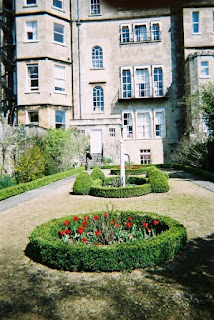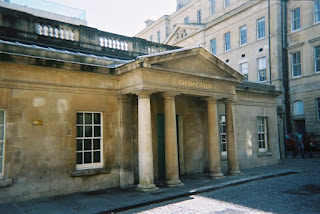Bath has a history far older than that of Jane Austen's tales, and to understand why Bath became what is was in Jane Austen's time, we must first understand what it was back then. Bath is built on sides of an ancient, and now extinct, volcano. And in this extinct volcano are hot springs. Hot springs believe to have healing properties.
Nobody quite knows who it was that first jumped in and decided the water was fine, though legend has it that is was the father of King Lear. Supposedly it cured him of leprosy. Probably he just wanted a good bubble bath. In any case, the ancient people of
Britton knew of these hot springs and used them in rituals to their sun god,
Sul, and for healing of various ailments.
Then the Romans barged in and started mucking about. Now, the Romans were in to bathing in a serious way. The ruins of their bath houses can be found all over Europe. And they were quite chuffed to find a natural hot spring in an easily fortified location that ALSO had healing properties. Oh,
yay! So, they built a temple to their goddess, Minerva (renaming her Minerva-
Sulin so as to please the locals), started a town, and named the town
Aquae Sulis - the Waters of
Sul.
After the Romans left, the walls and temple fell into disrepair. Not to fear, my friends! In charged the Saxons in the 6
th century and took over everything and pretty much life, and the baths, returned to normal. Or
normalish, anyway. Bath was a flourishing, if small, community. And some kings were crowned there and everyone was happy for awhile. But mostly the town struggled along in obscurity making a living off the waters.
In the 17
th century, Queen Ann came to drink the waters and the place (by now having been called Bath for a few centuries) took on a genteel shimmer and gained some standing among the upper classes, but it was still a small, sleepy town whose only claim to fame was the waters that, supposedly, healed the sick.
In the 18
th century, everything changed. Beau Nash became the Master of Ceremonies for the town and decided to ramp up the town's image. He had John Wood, the famous architect, design nearly all the buildings in bath. Street lamps were put in. Assemblies were scheduled. Plays put on. And anyone who was anyone (and even some who weren't) flocked to Bath for the "season".
This was the time in which Jane Austen visited, and lived in, Bath. At the height of its gentility. She set two of her novels in bath;
Northanger Abbey and
Persuasion.
During the Industrial Revolution, Bath lost some of it's importance, though it remained popular with tourists and those seeking cures from the waters. During this time, the old Roman Baths were rediscovered and excavations begun, but it was an
archaeological site not open to the public.
Fast forward to the 21st century. The Roman Baths have finally been opened to the public. The old pump room restored to it's former glory. In 2006 the
Thermae Bath Spa opened it's doors and Bath returned to, perhaps, it's original use... a place of relaxation and rejuvenation. Though, so far, no one has gone back to building any pagan temples. Bath is more popular than ever, especially with the resurgence of popularity for one of it's previous inhabitants... Miss Jane Austen.
You never know, there could be balls and games of whist just around the corner....
 I recovered from my trip to Bath fairly well, though I have come to the firm conclusion that Bath needs many more trips. Other adventures await, however, so Bath may have to wait a month or two for my return.
I recovered from my trip to Bath fairly well, though I have come to the firm conclusion that Bath needs many more trips. Other adventures await, however, so Bath may have to wait a month or two for my return. It is the former home of Sir John Mills (as in Haley Mills's dad), among other famous people. It's streets are tree lined, houses quaint, vines running over buildings and stone walls with wild abandon. It's posh, but it doesn't feel posh. It feels homey and lived in.
It is the former home of Sir John Mills (as in Haley Mills's dad), among other famous people. It's streets are tree lined, houses quaint, vines running over buildings and stone walls with wild abandon. It's posh, but it doesn't feel posh. It feels homey and lived in.  sun, good food, good friends, and conversation.
sun, good food, good friends, and conversation. 


























